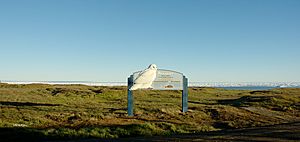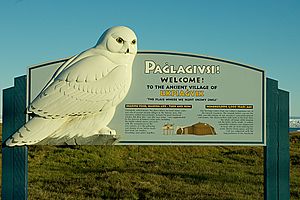Birnirk culture facts for kids
The Birnirk culture was an ancient culture of the Inuit people who lived along the northern coast of Alaska. They existed from about 500 AD to 1200 AD. The Birnirk culture started near the Bering Strait in America. It came after the Old Bering Sea/Okvik culture and before the Thule culture. The Birnirk people were known for their amazing harpoons and their skills in hunting sea animals.
Archaeologists have found places where the Birnirk people lived and were buried. One burial mound was found in Wales. Sixteen more were found in Utqiagvik at a place called the "Birnirk site." This site is now a special historical landmark. An old Birnirk village has also been found in what is now Ukpiaġvik.
Life and Homes
The Birnirk people lived in small homes, usually for one family. These houses had a long or short entrance that led to a single room. Inside, there were platforms where people slept. Their homes did not have open fires for heat. Instead, they used lamps made of stone or clay to provide warmth and light.
Birnirk villages were likely small, with only a few families living together. Because their settlements were so small, experts often discuss whether the Birnirk people hunted whales. Whaling usually needs many people working together. However, a whaling harpoon was found in Utqiagvik. Also, items made from whale parts, like bones, have been found at other sites. This suggests that the Birnirk people did hunt whales in some way. They also hunted seals, caribou, birds, and fish using different tools.
Hunting Tools
Many tools used by the Birnirk people have been discovered. They were very good seal hunters. They used clever tools like "ice scratchers" to attract seals over frozen water. Their harpoons were special, with a sharp point and a unique side blade. These harpoons were used for hunting seals and other sea animals.
Besides harpoons, the Birnirk people also used weapons made from ground slate. These included knives, blades, arrows, and spears. They used these tools mainly for hunting animals on land.
Their Ancestry
Scientists studied the DNA from five Birnirk people found in Siberia. These people lived between 570 AD and 680 AD. The DNA showed that they all belonged to a group called haplogroup A2a. This same haplogroup was also common among the Thule people. This genetic evidence suggests that the Thule people came from Birnirk people who moved from Siberia. They traveled into northern Canada and Greenland after 1300 AD. There, they replaced the Dorset people, who were genetically different.
See also
 In Spanish: Cultura Birnirk para niños
In Spanish: Cultura Birnirk para niños



